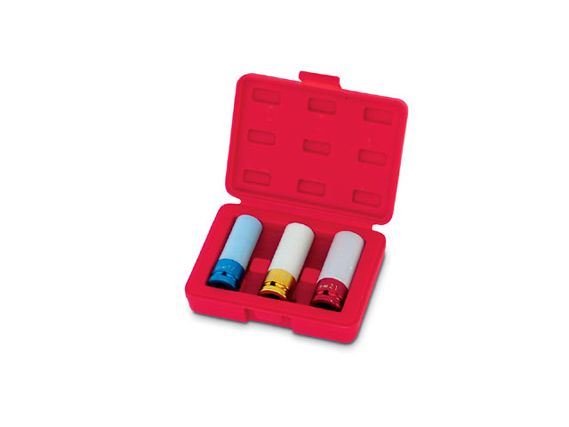 | Lug Nuts - Harbor Freight Alloy Wheel Lug Sockets
| Lug Nuts - Harbor Freight Alloy Wheel Lug Sockets
Let's face it: Most of us have spent a fair amount of money on alloy wheels, and the good ones aren't getting any cheaper. You can easily spend $2,000 to $3,000 on a set of nice wheels today, more if your tastes run toward the "bling" style. Expensive alloy wheels have become some of the most profitable parts in the aftermarket industry. So lots of us will whip out a credit card and spend more for a set of wheels than a halfway decent car would cost.
And then what?
The best-case scenario is we take them to an experienced European car technician or specialty shop for mounting and balancing performed in a craftsman-like manner-care taken not to damage the wheels; tires correctly mounted, properly inflated and balanced to the gram using nice adhesive weights (hopefully on the inside of the wheels); hubs cleaned and coated with anti-seize; lug bolts tightened with a lug bolt socket and torque wrench and not grossly over-torqued using a regular socket on a pneumatic impact gun. All is right with the world in the best-case scenario. But it's not always like that, is it?
Often, expensive alloy wheels go to the corner tire gorilla, who doesn't clean any wheel ever, let alone his shop, throws them around like yesterday's trash, mounts the tires as fast as possible, spins them up right quick sticking on used weights of different design, and chugs the lug bolts down with an ancient impact gun to the tightening torque specification for the U.S.S. Missouri propeller bolt. Right off the bat you've got a few marks on your wheels and maybe a suspension vibration, and no happy feelings about this wheel-off service.
Ever wonder why almost every time you buy a used car the alloy wheels are munged up? Well, obviously it's the driver who curbs wheels. But there are people in this world-in the tire business, in the automotive service business-who do not care about proper wheel and tire mounting, balancing, and installation procedures and techniques. I do not like these people.
One solution is to do your own tire and wheel work to the fullest extent possible, which usually means removing your wheels and tires and transporting them to whoever is going to do the mounting and balancing work, then reinstalling them on the car yourself. This could warrant its own article, but one step is to use dedicated alloy wheel lug sockets, like the ones we found for a lousy sixteen bucks at Harbor Freight (item number 40036). The three-socket set, made by our friends in the independent Republic of Taiwan, includes 17, 19, and 21mm half-inch-drive deep lug bolt sockets that feature a soft plastic exterior sheathe to protect the paint in the recessed area of alloy wheels, where your lug bolts live and work. Despite the price, these sockets appear to be very well-made of chrome-moly construction, and they fit tightly on both ends.
Can you use any old metric socket on lug bolts? Sure. But the trick is to keep them from scratching painted alloy wheels.
